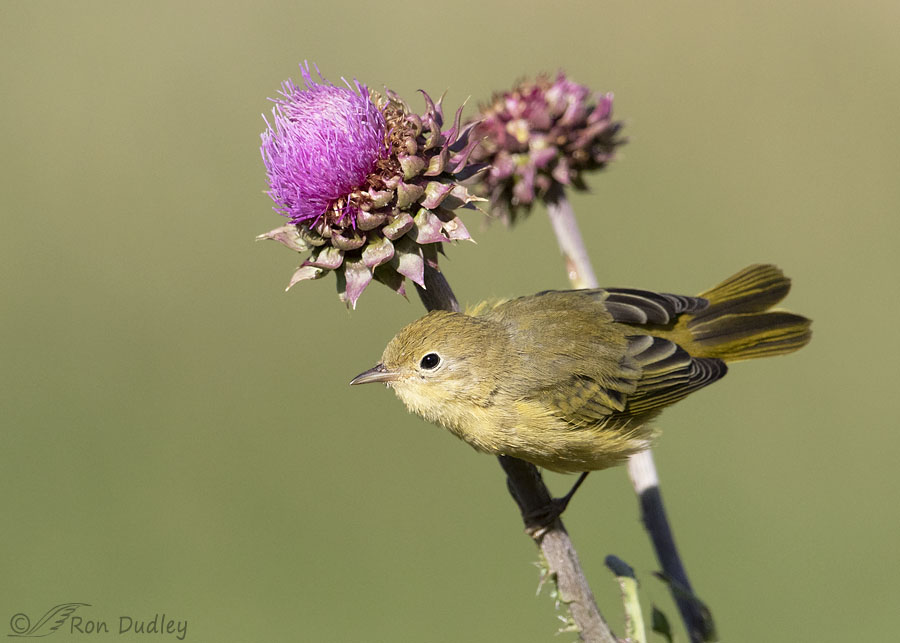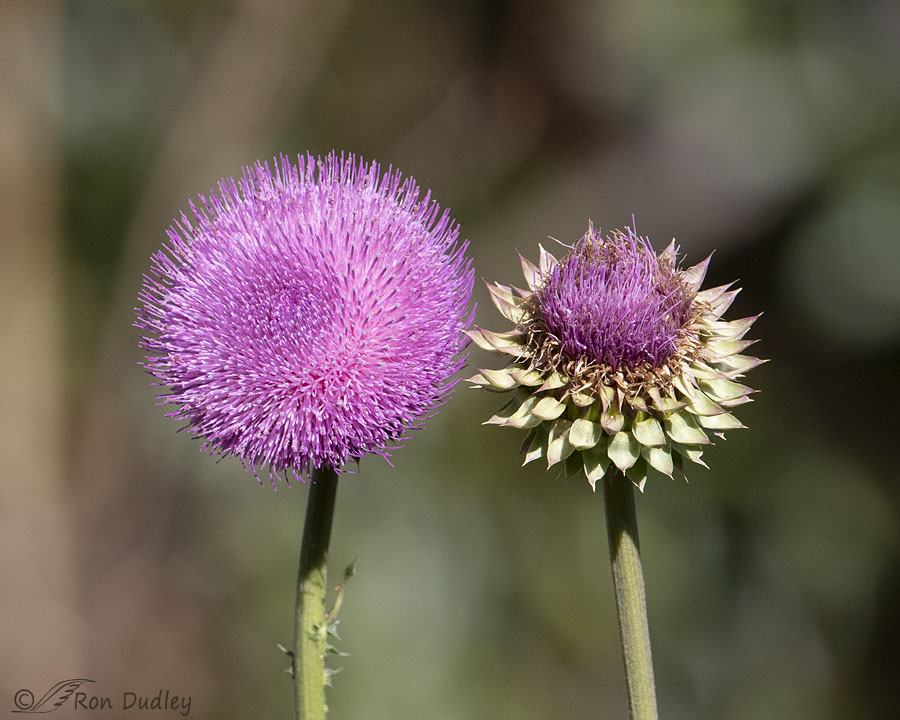Young birds are popping up all over the place in the mountains right now.

1/4000, f/6.3, ISO 800, Canon 7D Mark II, Canon EF 500mm f/4L IS II USM + EF 1.4 III Extender, not baited, set up or called in
Soon after photographing the Belted Kingfisher and its Barn Swallow tormentor two days ago I spent some time with some young Yellow Warblers on blooming thistle. They were busily feeding on aphids and maybe their ant attendants on the thistle.
The warblers were slightly side lit and they usually had their heads down as they looked for aphids so I found it difficult to get light in their eyes but this one looked at me long enough for a single shot that included a catch light.

I can’t help but like the thistles even though they’re an introduced species that is often considered to be a noxious weed. Their showy flowers can provide a very attractive and interesting setting for bird and nature photography since a variety of critters feed on their seeds and the insects that crawl all over them in great numbers.
But as a Montana farm boy I do understand the flip side. One of the most difficult weeds to eradicate we had in our barley and wheat fields was a related species of invasive thistle farmers up there always called ‘Canadian Thistle’. Once a patch of that nasty stuff got started in a field it was almost impossible to eradicate and man did it ever spread. Virtually nothing else grows in a thick patch of thistle and during harvest our combines had a hell of a time getting through it or going around it.
I remember the three weeds we hated most in our fields were wild oats, bindweed and Canadian Thistle, not necessarily in that order..
But at this point in my life I’m a bird photographer so I like thistle, at least in some ways. I guess it depends on your perspective.
Ron
Note: On this morning I took many photos I like of Yellow Warblers and American Goldfinches feeding on thistle (actually on insects on the thistle). But after yesterday’s marathon kingfisher post I thought we all needed a bit of a break so I decided to keep today’s post relatively short. I’ll probably post some of those photos at a later date.


(Coming to this late today. I had surgery on my eye earlier this week. I have a protective patch I wear each night for the next few days and I didn’t get it off today until very late.)
You mentioned that the birds were eating the insects on the thistle, but in the case of the Goldfinch, that would not be the case. Insects are eaten by goldfinches only as an accident. They will not deliberately seek insects for food. Nearly all songbirds take insects to feed their young as seeds are hard to digest and insects provide easily available protein. But American Goldfinches are an exception feeding raw seeds from day one. They depend on thistle and other small-seeded plants and thistle down is collected to make the nest. House Finches also don’t ear insects but the feed their young a partially digested mass of seeds. An interesting aside: Teasel is prominent throughout much of the country. It is introduced and invasive. But goldfinches love their small seeds.The seeds are deep within the very prickly flower heads. The goldfinches sometimes wound themselves trying to reach the seeds. European Goldfinches have a very slightly longer bill and can reach those seeds. They co-evolved with the plants but American Goldfinches did not and don’t feed on native plants that require that longer bill. An interesting example of environment driving evolution.
Fascinating stuff, Dan! It sure looked to me like the goldfinch I was photographing was eating aphids. I’ll check my images carefully and see what I can see.
Good luck with that eye!
I like the color transitions in the first shot. The warbler’s feathers almost seem to have a greenish tint that matches the green in the bracts of the thistle, then the purple parts of the bracts lead my eye to the purple thistle.
Good. Thanks, Marty.
They look quite similar to the Scotch thistle here – which has the dubious distinction of being the first plant recognised as a pest – in the 1850s. And yes, the birds and insects love them, and help to spread them. Squatting on one in a nature call in the dark is not a lot of fun.
Accepting (and agreeing) with your perspective is everything stance of the day, I do love this series. And the yellow warbler looks like a pint sized charmer. Thank you.
“Squatting on one in a nature call in the dark is not a lot of fun”
Which is why I seldom if ever squat, EC. Or at least one of the reasons..
Or at least one of the reasons..
I was younger and more agile then. MUCH more agile. I got up a great deal faster than I sat down though.
A friend of mine squatted in a patch of poison ivy…he regretted it, “bigly”.
Patty, a male teaching colleague of mine once used stinging nettle for toilet paper.
Talk about regret…
Oooooooh!
Hi Ron, as you probably know, not all thistles are introduced or considered noxious weeds. Utah has several species of native thistle that are valuable food sources sought out by wildlife and pollinators both. Thought I’d mention this so folks don’t pull up or stomp on every thistle they come across. Sadly, I’ve seen many native thistles destroyed along mountain trails.
Thank you for sharing your photos and stories. I enjoy them very much!
That’s right, Sarah. Good reminder.
Never remember having to pick grain, but if so I would definitely have hated thistle. But like you, as a bird photographer I love it. Makes for colorful shots with various birds perched on them.
“Never remember having to pick grain, but if so I would definitely have hated thistle”
Especially when the grain is your only source of income, Everett. Then you take it personally.
A lovely little yellow warbler, so I’m looking forward to seeing more of him/her and others in the coming days. Thistle *is* pretty but I remember it from childhood summers spent at my grandparents’ home in Saskatchewan, much too scratchy for my enjoyment!
Thanks, Chris. Scratchy is an understatement in my experience.
I guess I will need to take a drive next week. The photos are lovely. As a kid I never wore shoes no matter the terrain. Those thistles in the grass were not pleasant to step on but I do like the flowers. When it comes to bindweed it is the bane of my life as a gardener!
April, it’s amazing how many sharp spines, we used to call them ‘stickers’, there are on those thistles and the birds cling to them like they’re not even there.
Hi Ron, great pic. Regarding your feelings toward thistle, now and historically; I have a similar feeling towards blackberry bushes. When I was a kid, we had a constant war against the blackberry bushes invading our garden. Now, I’m growing a patch of blackberry bushes in the backyard — for the birds to hide and nest in. It’s amazing how many small birds are attracted to the berry bushes. Most entertaining lately have been the Wilson’s Warblers, which I love. Thanks for continuing to share your pics and birding insights!
Rick
Yes, sounds like a very similar situation, Rick. When I was living on the farm I was sure those thistles didn’t have a single redeeming quality.
I’m glad you’re accompanied by these lovely yellow birds, and i’m waiting for the day when they return to FL. And re: these lovely colored thistles, i guess you can say one man’s pain is another man’s joy. Thanks for sharing.
“one man’s pain is another man’s joy”
Yup, a perspective thing…
Great shots!
We have Canadian Thistle also, and even though Goldfinches are all over it when it goes to seed, its underground stems and root systems are impossible!
Thanks, Dick. MT farmers really hate that thistle.
Pretty little birds… The gold finches and others REALLY enjoy the thistle and they do have pretty flowers. That being said…… the “morning glory” aka bindweed and Canadian Thistle are horrible to deal with. Trying to cultivate out either just spreads them and even spraying takes several years and a lot of luck.
The gold finches and others REALLY enjoy the thistle and they do have pretty flowers. That being said…… the “morning glory” aka bindweed and Canadian Thistle are horrible to deal with. Trying to cultivate out either just spreads them and even spraying takes several years and a lot of luck.  It’s been a “weedy year” – one of those “where do I start?” things. Think the horrible winds and dirt blowing last winter didn’t help. Have yellow clover like we’ve never seen tho we certainly don’t consider that a weed!
It’s been a “weedy year” – one of those “where do I start?” things. Think the horrible winds and dirt blowing last winter didn’t help. Have yellow clover like we’ve never seen tho we certainly don’t consider that a weed! 
Judy, I have many unpleasant memories of “plugging up” while driving tractor and having to stop to clear all the bindweed off of the cultivator shovels and shanks. I bloodied my head countless times by banging it on the cultivator frame while I was beneath it clearing bindweed off of the shovels. I started driving tractor at a very young age and hell, plugging up is when I first learned to swear…
Bindweed is nasty stuff and very well named.